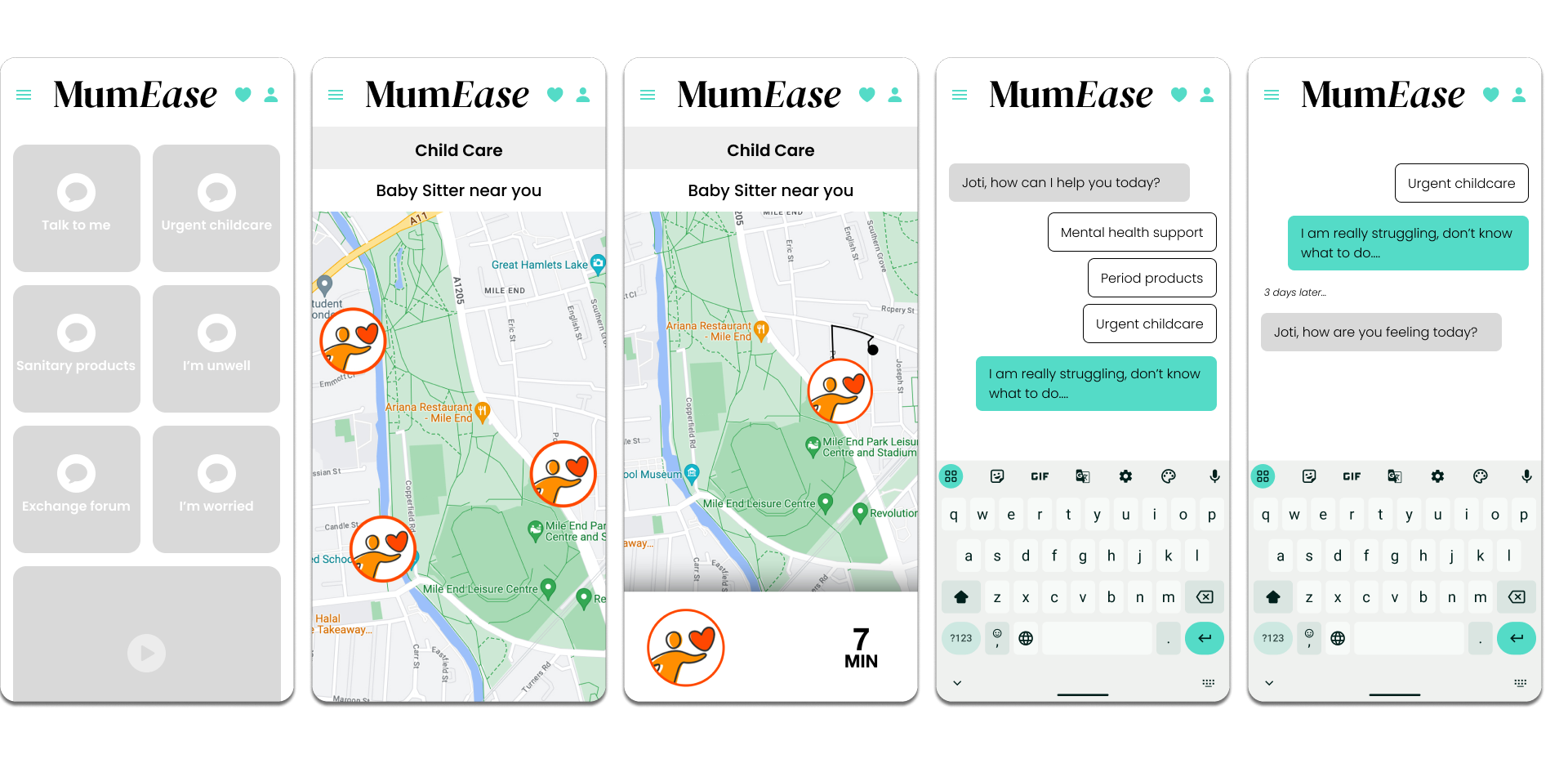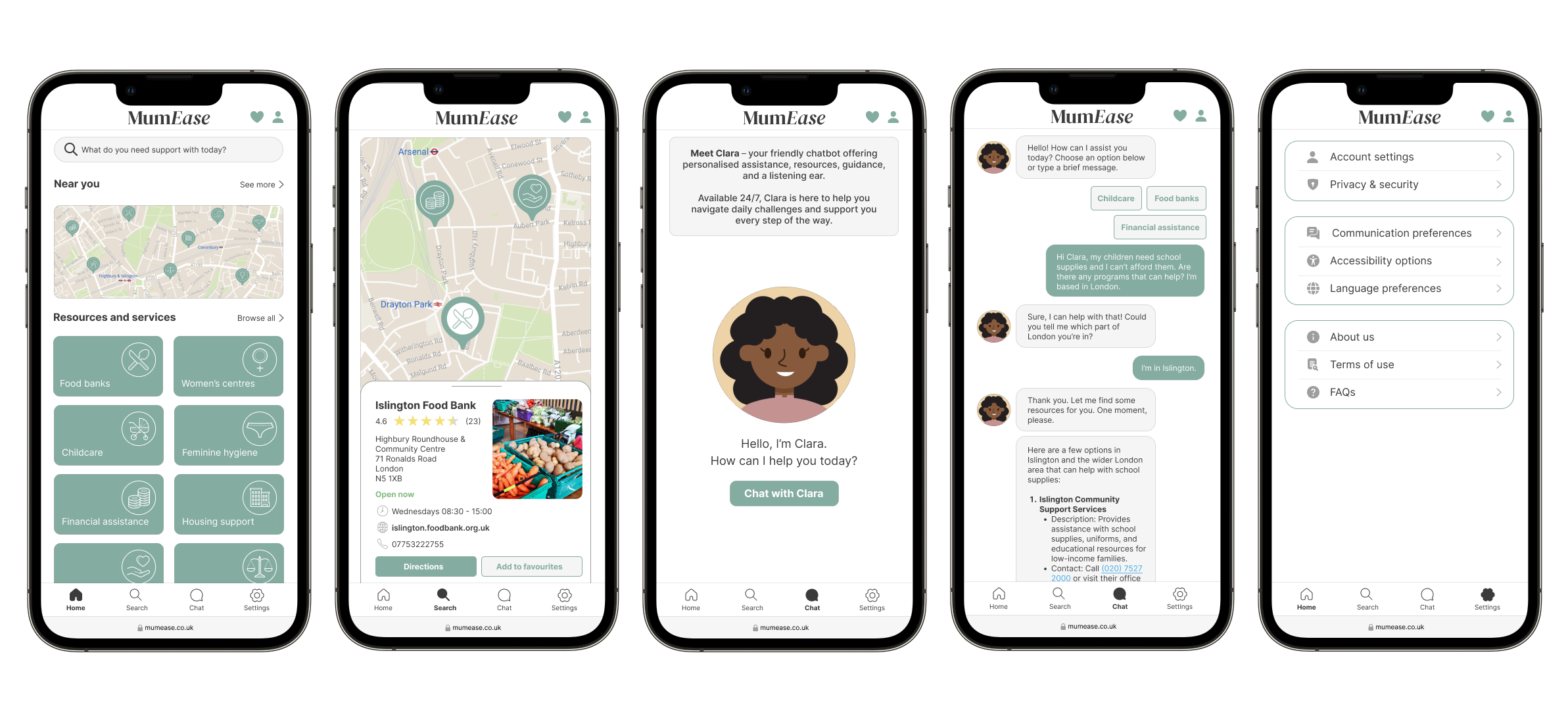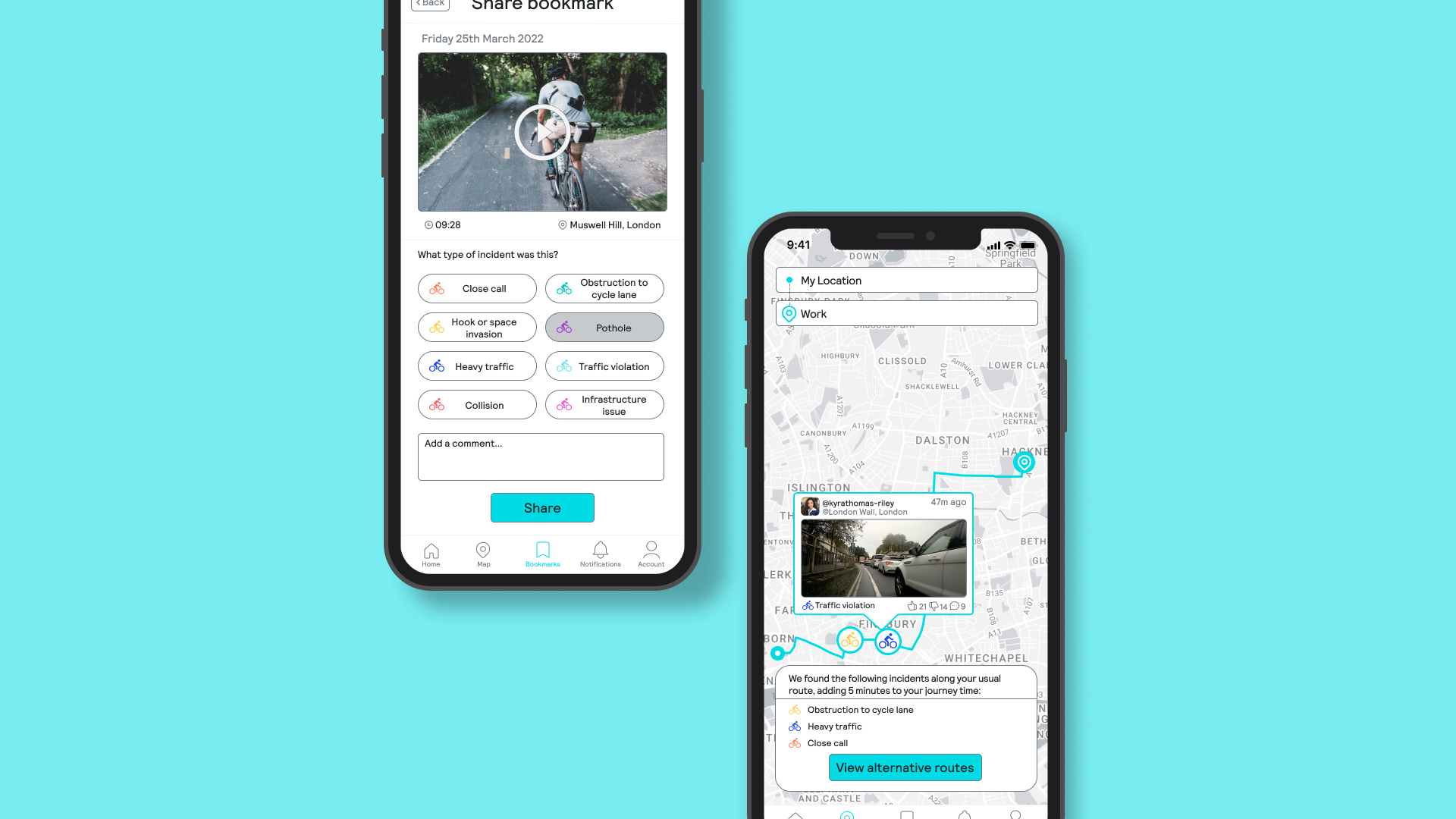Overview
MumEase supports single mothers by providing access to information and a friendly chatbot offering personalised assistance.
This innovation design day was facilitated by Hauslabs, an internal innovation lab at Experience Haus dedicated to building impactful ventures. The objective was to address the needs of the estimated 2.5 million Londoners living in poverty. In separate teams of designers, each of us focused on a different community experiencing poverty in London. My team focused on single mothers.
My role
This was a one-day hackathon style project where I was part of a team of 5 designers. I worked on our user research, competitor analysis, the SME interview and UI design. I later spent time working on the UI designs alone.
Duration
1 day (Sept 2023) [ + 1 week alone enhancing high-fidelity designs]
Tools
Figma, Slack, Google Slides, StoryTribe, Pen + paper
The problem
Poverty is a pressing issue in London, impacting numerous communities and hindering their access to healthcare, housing and education.
Single mothers face additional barriers in securing childcare, basic necessities like food, employment, and mental health services, amplifying cycles of economic insecurity and social marginalisation.
The solution
MumEase facilitates access to essential resources for single mothers in need, providing crucial support.
background
Each team was given a set of resources with information related to a number of poverty-stricken communities in the capital. Our task was to design a digital product to meet the needs of one of these groups. My team decided to focus on single mothers and started digging deeper into this community through additional research.
User research
Existing studies gave us more insight into the experiences of single mothers in London.
Through secondary research, we uncovered key statistics about this community and their experiences. This allowed us to start identifying pain points and unique needs, ensuring that we proceeded with a user-centric approach.
Subject Matter Expert interview
We interviewed a Senior Health Professional to learn more about the existing support available.
Arup Paul, an industry expert with experience spanning NHS England, AXA, and GP surgeries, was present at the innovation design day to share expert advice. He provided valuable insights, improving our understanding of the landscape.
Lack of tailored support: existing healthcare initiatives often lack tailored support for single mothers, exacerbating their challenges.
Digital and healthcare poverty: digital and healthcare poverty intersect, limiting single mothers' access to essential resources.
Macro environment matters: understanding broader socio-economic factors is vital for addressing single mothers' health challenges, especially in urban areas.
Financial strain: financial hardship worsens social mobility for single mothers, exacerbated by benefit cuts and reliance on food banks.
Mental health services gap: single mothers face significant barriers accessing mental health support due to budget cuts and long wait times.
Key insights
We then outlined the main pain points and challenges for economically disadvantaged single mothers in London.
These included food and housing insecurity, childcare costs, language barriers, restricted employment options and difficulty accessing healthcare.
Competitor analysis
I reviewed existing digital services supporting single mothers.
My goal was to explore other digital products in this problem space, identify any gaps in their offerings and begin to consider the opportunities for a solution. This exercise revealed a lack of services tailored specifically to women, with most platforms catering to single parents in general. Additionally, I found that information was frequently presented in traditional formats, such as articles.
Defining the persona
Meet Anika — single mother living in Tower Hamlets.
Our research findings shaped the development of a user persona capturing some of the behaviours and challenges of our target audience, helping us understand the emotions and experiences of potential users.
How might we?
How might we improve access to critical services for single mothers experiencing poverty in London, empowering them to better navigate challenges like childcare, housing, and financial instability?
Ideation
The "Crazy 8s" challenge kickstarted our brainstorming process.
Each of us sketched out eight bad and then eight good ideas to generate initial ideas for key features and functionality. This exercise was particularly valuable given the time constraints.
We discussed our different design ideas and selected the key features to move forward with. Recognising the gap in the market from our research, we opted for a progressive mobile web app and named it MumEase.
Our goal was to streamline access to essential services, reducing the hardships that poverty creates for single mothers and ultimately enhancing their outcomes and quality of life.
Feature prioritisation
Establishing the key product features for MumEase.
Map navigation: enabling users to easily find, access and navigate to local support and resources such as food banks, childcare options, and women’s support centres.
Centralised resource library: offering a comprehensive one-stop platform for accessing information and support services related to financial assistance, housing support, legal aid, mental health and more.
AI chat bot: available 24/7, ensuring round-the-clock support and maintaining user privacy for mothers hesitant to seek help due to privacy concerns, stigma, or fear of judgement. The chatbot can offer empathetic and supportive responses to users in emotional distress and gather user-specific information for personalised assistance and guidance to suitable services.
Accessibility considerations: particularly important given the potential circumstances of our target users — a multilingual service would cater to our diverse user base in London; a progressive web app is accessible from any device with a web browser, eliminating the need for downloads from app stores and is therefore more inclusive for those with limited mobile storage or slower internet connections; offline capability extends support to those with restricted data plans or infrequent Wi-Fi access.
User storyboarding
We developed a storyboard to illustrate how Anika might interact with MumEase.
Design
High-fidelity designs.
We created the high-fidelity wireframes in Figma, prioritising the key features for our MVP. However, due to the limited time scope, we couldn't develop these features as much as we would’ve liked to.
My final designs.
I later dedicated time outside of the hackathon to refine the high-fidelity screens for MumEase. This allowed me to delve deeper into the UI and user journey beyond the constraints of the design day, enriching the product experience and bringing it to life.
This was a great opportunity to exercise my creativity and get more comfortable with using Figma.
Searching for and navigating to local resources or services:
Chatting with Clara, the chatbot, to receive personalised assistance:
Next steps
Hauslabs is hoping to explore the viability and feasibility of the approaches that emerged from all teams on this design day and take them forward into development. More details can be found here.
key takeaways
My reflections:
Design helps make a difference — this experience highlighted how we can use design to address real-world challenges and improve the lives of those in society who need support most. As someone who enjoys helping others, I appreciated seeing first-hand how user-centred design can create experiences that are both meaningful and functional.
Agile teamwork — working in a one-day hackathon-style environment demonstrated the power of agile collaboration. Our team effectively pooled our strengths to delegate tasks, showcasing the importance of teamwork and communication in achieving ambitious design goals within tight timelines.
Crazy 8s can be a valuable tool — the exercise sparked a rapid flow of creative ideas, urging us to think divergently and generate innovative concepts in a short time span. Between 5 designers, we produced 40 “good” ideas, with some concepts even overlapping, making it a really fun and collaborative way to ideate effectively and consider key functionality.
User research is essential — project constraints prevented us from speaking directly with single mothers, who make up our user base. This would have given us a clearer and more accurate understanding of the community and helped us avoid making assumptions. Although we couldn't do it this time, it has reinforced the importance of engaging with the real people who will use a product.














